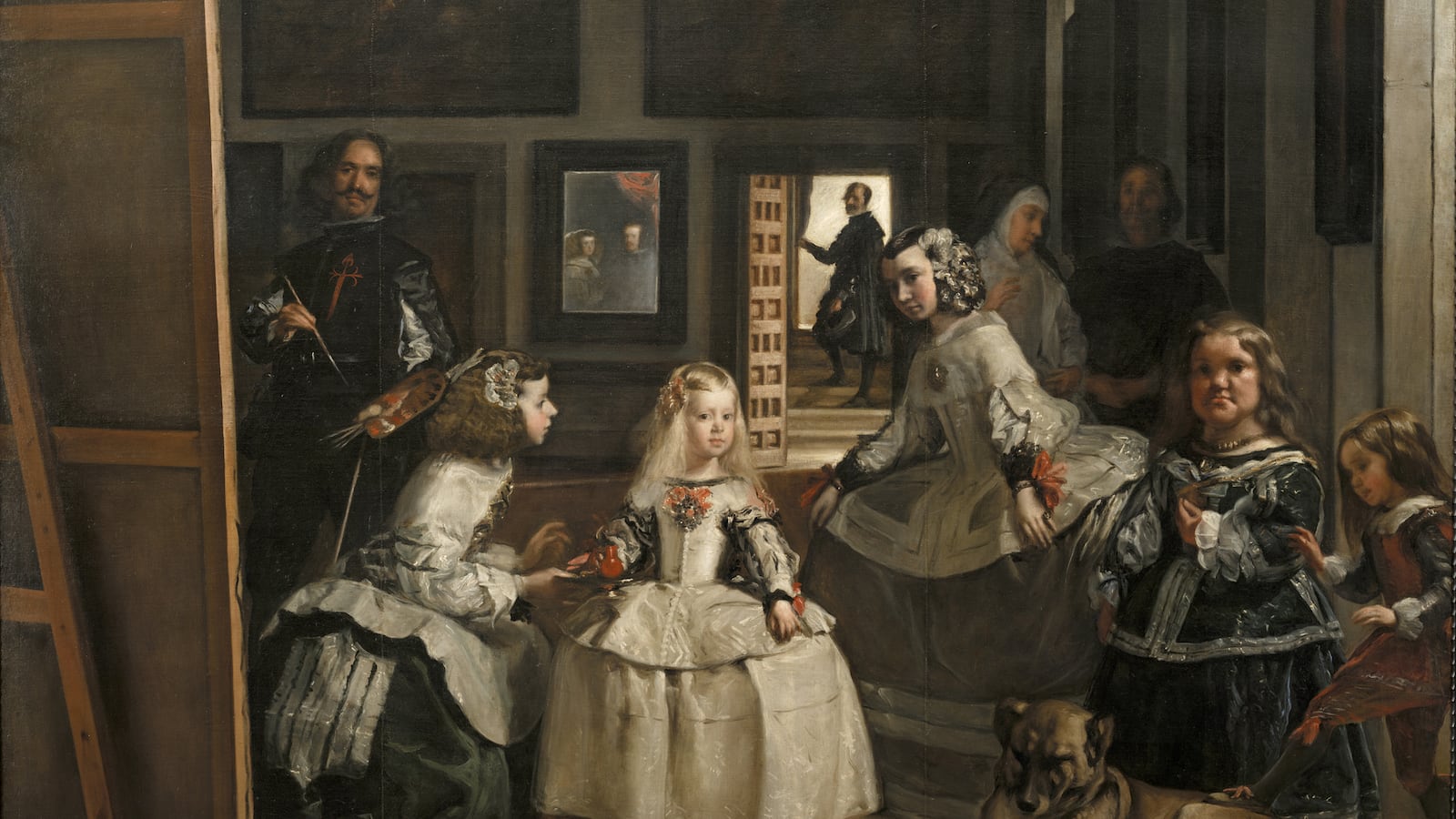My father died quite suddenly when I was in my late twenties. He was a painter. The fatal illness attacked first his brain and then his eyes. In my raging grief, I took a vow never to look at anyone else’s paintings but his, as a way of holding him as close as possible.
Months passed and eventually my mother persuaded me to take a trip to Madrid, which is where everything went wrong—or perhaps right. For the center of Madrid is so small I couldn’t help passing the Prado every day until the effort to avoid it in itself became a distraction from thinking about my father. So this is where I broke my vow and came upon the greatest of paintings completely by chance. I didn’t even know that it was there.
Flashing up before me was Velázquez’s Las Meninas, large as life and fully as profound: the little princess, her maids and servants and the artist himself, all gathered in a pool of sunlight below a heavy volume of shadow that instantly sets the tenor of the scene. The moment you set eyes on them, you know these beautiful people will die, that they are already dead and gone, and yet they live in the here and now of this moment, brief and bright as fireflies beneath the sepulchral gloom. And what keeps them here, what keeps them alive, or so the artist implies, is not just the painting but you.
You are here, you have appeared: that is the split-second revelation in their eyes. They’re like guests at a surprise party waiting for your arrival, and now you have entered the room—their room, not the real room around you in Prado—or so it mysteriously seems. The image holds you there, amazed, motionless as the moment it represents. Everyone sees; and everyone is seen.
But take a few steps towards the painting in all its amazing veracity and the vision withers. The princess’s hair becomes a mirage, the background figures are inchoate; you can no longer see where a hand stops and the tray it is holding begins. The nearer you get, the more these semblances of reality seem to disappear. Everything is on the verge of dissolution and yet so vividly present that the sunshine in the painting seems to float free and drift out into the gallery. It is, I think, the most spellbinding vision in art.
Velázquez keeps this vanished circle before you like the moment’s reflection in a mirror: look into it and you are seen in return. And anyone who stands before Las Meninas now, held fast by the eyes of these lost children and servants, is positioned exactly where the people of the past once stood; it is part of the painting’s content. It elects you to the company of all who have ever seen it, from the princess and her maids, who must have rushed round to see themselves the moment Velázquez finished, to the chamberlain in the glowing doorway at the back, the king and queen in the mirror, and onwards through history. You stand where they once stood, the mirror implies, and the servants’ eyes. You are part of Velazquez’s democracy.
What I felt that day was that the painting seems to hold death back from the brink, even as it acknowledges our shared human fate. It shows the past, and yet it also looks forward into the flowing future—to the moment of our arrival. Because of Velázquez, these long-lost people will always be waiting for us in the Prado; they will never go away as long as we hold them in sight. For me the picture is like a chamber of the mind, a place where the dead will never die. My gratitude to Velázquez is boundless: he gave me the consolation to return to my life.
Back in London, I immediately read what others had written about the masterpiece, and was shocked to find them squabbling over exactly what Velázquez was painting on his enormous canvas (this picture, or something else?), whether the perspective was correct, whether the dog was a mastiff or a mongrel. I read Michel Foucault’s famous essay declaring that the painting was nothing less (and perhaps nothing more, for him) than a representation of representation. But nobody spoke about the grace of Velázquez’s vision, how much it moved them and why; the way it opens out to give us all a part in its theatre. I have seen people weep before Las Meninas and I have done so myself. I think of it every time I sit down to write a review: it confirms me in the view that artists do not paint with the limited hope of reaching only our eyes.
We see paintings in time and place—no picture makes this clearer, putting us on the spot and in the moment—and always in the context of our own lives. We cannot see them otherwise, no matter how objective we might hope to be. Novelists long ago recognized this truth; literature is full of characters falling in love with the people in paintings, obsessing over enigmatic figures or shapes, feeling intimidated—or intensely disappointed, in the case of Madame Bovary—by their first sighting of a tarry Old Master. Fictional people are allowed to have feelings about art entirely unconnected with the analysis of formal attributes, still less any knowledge of art history. But this is not how the rest of us are encouraged to view art by specialists and historians, for whom feelings may be dubious, unstable, or irrelevant. If one should happen to experience an involuntary personal response, an eminent art historian once advised me, as if mentioning some embarrassing arousal, one should always keep it firmly to oneself.
Over time, many scholars have written about the mysteries of Las Meninas: who the painter is looking at, what the mirror reflects, what is happening in the picture, how it was constructed. But Velázquez’s compelling humanity is ignored. Some historians actually believe the painter was only talking to himself or his employer, Philip IV of Spain, the little king in the mirror; so that all the beautiful open-ended complexities that have enthralled viewers down the centuries are either our mistaken fantasy or a closed conversation between two 17th century men. Yet Las Meninas is living proof of the opposite, that when painters make images, they do not do so in some kind of austere isolation or without hope of an audience beyond the studio. For this painting accepts as many interpretations as there are viewers, and part of its grace lies in allowing all these different responses to coexist, no matter how contradictory, by being such a precise vision of reality and yet so open a mystery. Velázquez is able to make you, and all before and after you, feel as alive to these people as they are to you. The knowledge that this is all achieved by brushstrokes, that these are only painted figments, does not weaken the illusion so much as deepen the enchantment. The whole surface of Las Meninas feels alive to your presence.
This is at least as central to the technical feat of the painting as it is to our personal response. But there seems to be some scholarly recoil from the idea that art might actually overwhelm, distress, or enchant us, might inspire wonder or tears, that it might raise us up as a Shakespeare tragedy raises its audience. Yet so many people have loved Velázquez’s late masterpiece—it is not too strong a word—and I am one them. Las Meninas changed my life.
Laura Cumming has been the art critic of the Observer since 1999. Her book The Vanishing Velázquez is published by Scribner.






